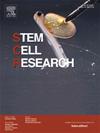Generation of a human iPSC line with Notch3 R133C mutation by CRISPR/Cas9: A tool for investigating CADASIL and therapeutic targets
IF 0.8
4区 医学
Q4 BIOTECHNOLOGY & APPLIED MICROBIOLOGY
引用次数: 0
Abstract
Cerebral autosomal dominant arteriopathy with subcortical infarcts and leukoencephalopathy (CADASIL) is a rare neuro vascular disease that is caused by mutations in Notch3. Here, we developed an iPSC line harboring the R133C mutation in Notch3, which is among the most common mutations leading to CADASIL. This mutation alters the disulfide bonding pattern leading to Notch3 protein aggregation, granular osmiophilic material (GOM) formation and vascular changes. The iPSC line was generated using CRISPR/Cas9 and edits were confirmed by PCR and Sanger sequencing. This resource is a valuable tool for studying molecular mechanisms of CADASIL and enabling the development and screening of targeted therapies for Notch3-related pathologies.
利用CRISPR/Cas9构建Notch3 R133C突变的人类iPSC系:研究CADASIL和治疗靶点的工具
脑常染色体显性动脉病变伴皮层下梗死和白质脑病(CADASIL)是一种罕见的由Notch3突变引起的神经血管疾病。在这里,我们开发了一个包含Notch3中R133C突变的iPSC系,这是导致CADASIL的最常见突变之一。这种突变改变了二硫键模式,导致Notch3蛋白聚集、颗粒亲锇物质(GOM)形成和血管变化。使用CRISPR/Cas9生成iPSC系,并通过PCR和Sanger测序确认编辑。该资源为研究CADASIL的分子机制以及开发和筛选靶向治疗notch3相关病理提供了有价值的工具。
本文章由计算机程序翻译,如有差异,请以英文原文为准。
求助全文
约1分钟内获得全文
求助全文
来源期刊

Stem cell research
生物-生物工程与应用微生物
CiteScore
2.20
自引率
8.30%
发文量
338
审稿时长
55 days
期刊介绍:
Stem Cell Research is dedicated to publishing high-quality manuscripts focusing on the biology and applications of stem cell research. Submissions to Stem Cell Research, may cover all aspects of stem cells, including embryonic stem cells, tissue-specific stem cells, cancer stem cells, developmental studies, stem cell genomes, and translational research. Stem Cell Research publishes 6 issues a year.
 求助内容:
求助内容: 应助结果提醒方式:
应助结果提醒方式:


